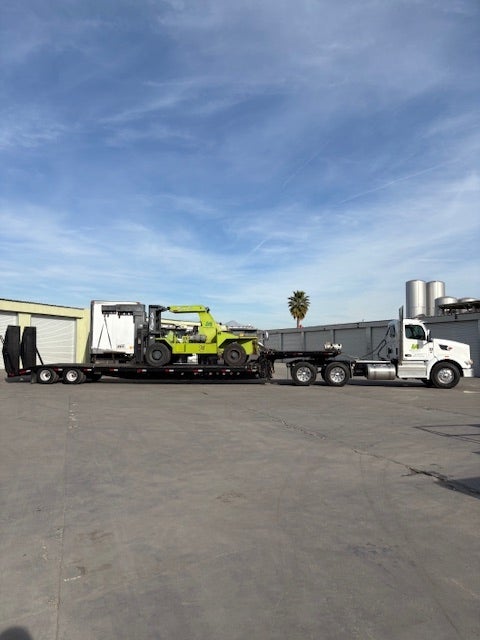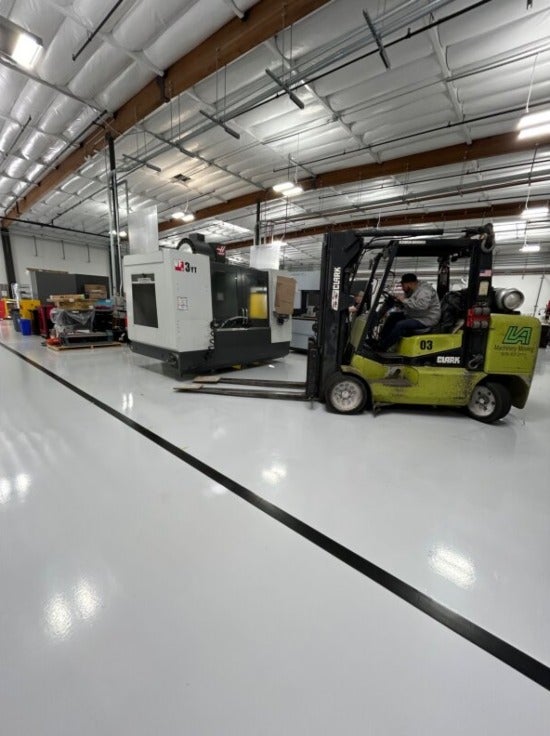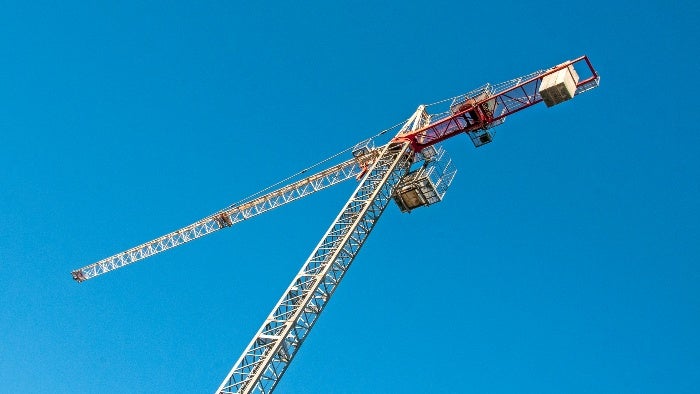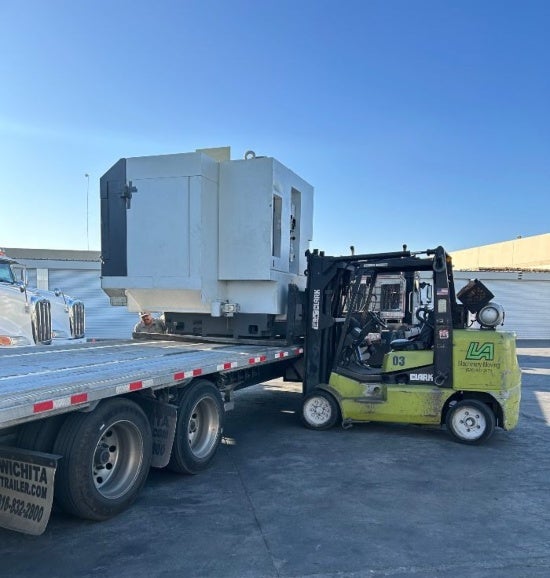-
Safety Tips for Working Around Heavy Equipment
Operating and working around heavy equipment requires strict safety measures to avoid accidents and injuries. At LA Machinery Moving, we’ve spent over 30 years moving and handling industrial machinery, so we know how important it is to maintain safety standards. Whether you’re managing equipment vehicles or heavy machinery on-site, following these safety tips can protect both workers and equipment.

The Significance of Heavy Machinery Safety
Heavy equipment working environments can be hazardous without proper precautions. Accidents can result in serious injuries, delays, and financial losses. By prioritizing safety, you create a safer workspace for heavy equipment operators and others nearby.
Equipment Safety Tips
- Examine Equipment Before Use – Always inspect machinery before operation. Look for wear, leaks, or other signs of damage. Regular checks help identify problems early, keeping equipment safe and functional.
- Maintain Three-Point Contact – When climbing on or off heavy machinery, maintain three-point contact (two hands and one foot, or two feet and one hand) to prevent slips or falls.
- Wear a Seatbelt – Seatbelts aren’t just for cars; they’re essential when operating heavy equipment vehicles to prevent being thrown from the seat during sudden stops or uneven terrain.
- Be Alert to Blind Zones – Heavy equipment operators must stay aware of blind spots. Use mirrors and cameras to monitor surroundings and to make sure that no workers are in these dangerous zones.
- Understand Your Boundaries – Establish clear boundaries around operating equipment. Workers should maintain a safe distance and communicate effectively with operators when entering these areas.
Risks When Working Near Heavy Machinery
Working around heavy equipment involves multiple risks:
- Mechanical Risks – Moving parts can pose dangers if workers come into contact with them or if equipment malfunctions.
- Non-mechanical Dangers – Noise, vibration, and emissions can impact health over time without proper safeguards.
- Accessibility Risks – Limited access to controls or areas can lead to unsafe actions, especially during emergencies.
Safety Guidelines to Prevent Accidents
Preventing accidents starts with implementing safety-focused guidelines. Here are several steps to help reduce risks:
- Wear Protective Equipment – Personal protective equipment (PPE) like hard hats, gloves, goggles, and steel-toed boots provides critical protection against workplace hazards. High-visibility vests are also necessary in areas with moving equipment.
- Confirm Machines Are Safe – Before operating machinery, verify that it’s in proper working condition. Even minor malfunctions, like a loose bolt or a damaged hydraulic line, can lead to accidents if overlooked.
- Conduct Pre-use Inspections – Pre-use inspections should include checking brakes, lights, fluid levels, and tires. Using a checklist ensures that all key components are reviewed, keeping both operators and equipment safe.
- Carry Out Regular Maintenance – Routine maintenance is essential for preventing unexpected breakdowns. Schedule regular servicing to identify and repair wear and tear before it leads to equipment failure. This keeps machinery reliable and extends its lifespan.
- Stay Focused – Distractions can lead to mistakes, especially in high-risk environments. Operators should remain focused on their tasks, avoiding unnecessary conversations, phone use, or multitasking while working.
- Operate Equipment Only with Proper Training – Heavy machinery should only be operated by trained and certified personnel. Training ensures that operators understand equipment controls, safety protocols, and how to respond to emergencies.
- Keep the Work Area Clear – A cluttered workspace increases the risk of accidents. Remove debris, tools, or other unnecessary items from the area to allow operators to maneuver safely and efficiently.
LA Machinery Moving Prioritizes Safety
At LA Machinery Moving, we’ve built a reputation for safe, efficient equipment handling. Our team is highly trained in the latest safety protocols, and we use specialized tools to protect your machinery during every step of the move. With over three decades of experience in Los Angeles, we understand the unique challenges of heavy equipment relocation and work to eliminate risks wherever possible.
How We Support Your Business
We offer comprehensive moving services, from pre-move planning to equipment setup. Our commitment to safety and efficiency means that your machinery will arrive at its new location on time and in perfect condition. Visit our services page to learn more about how we can assist with your next move.
Summary
Safety is an ongoing effort in any workplace, especially when working with heavy machinery. Following these guidelines can help reduce risks, protect workers, and maintain a productive job site. For professional support, trust LA Machinery Moving to handle your heavy equipment with care and expertise.
Ready to move your heavy equipment safely? Reach out to LA Machinery Moving to learn more about our services. Fill out our contact form or give us a call to speak with a member of our experienced team. Let us help you create a safer and more efficient workplace!
-
10 Tips for Heavy Machinery Storage
Do you need to store heavy machinery like excavators, cranes, forklifts, or bulldozers? Prioritizing proper storage extends your equipment’s lifespan and ensures easy accessibility the next time you need it. Whether you’re storing machinery between jobs or preparing for a long off-season, the right preparation can save you from costly downtime and repairs when you retrieve the equipment from storage. Here are some tips to help you safely store your heavy machinery.

1. Check the Manufacturer’s Storage Recommendations
Before preparing your equipment for storage, review the manual to ensure you’re following the manufacturer’s best practices. If you don’t have a physical manual, check the website or call customer support. You may learn important details about fluid levels, battery care, and tire pressure. Some manufacturers may also recommend certain covers or specify conditions for short- vs. long-term storage.
2. Clean the Equipment
In preparation for storing your heavy machinery, clean it thoroughly to remove dirt, grease, and debris. Dirt can cause corrosion, while grease and grime buildup may lead to operational issues when you put the equipment back into use. Pressure washes the machinery, paying close attention to hard-to-reach areas where debris may accumulate. Let the equipment dry completely to prevent residual moisture from causing rust during storage.
3. Inspect for Repairs
Once the machinery is clean, perform a detailed inspection for existing damage or wear. Address issues like hydraulic leaks, worn belts, or loose bolts to prevent more significant damage from developing during storage. Conducting repairs beforehand also ensures that the equipment is in working order when you need it.
4. Lubricate Moving Parts
Lubrication prevents friction and rust while your equipment sits idle. Apply the recommended lubricant to all joints, bearings, and pivot points to create a protective moisture barrier. This is especially important for equipment with many moving parts, like excavators and cranes.
5. Change Fluids and Add Stabilizers
For machinery with engines, changing the oil and fluids before storage prevents contamination and engine damage. Be sure to top off the coolant and hydraulic fluid to avoid freezing or corrosion in the system. If you’re storing equipment for a few months or longer, add a fuel stabilizer to the tank to prevent fuel degradation. Run the engine briefly after adding the stabilizer to allow it to circulate through the system.
6. Remove or Disconnect the Battery
If your equipment won’t be used for an extended period, it’s wise to remove the battery and store it separately in a cool, dry place. Disconnecting the battery prevents it from slowly draining over time and extends its life. If removing the battery isn’t practical, at least disconnect it to avoid drainage or electrical issues.
7. Protect Electronics and Sensitive Components
Heavy machinery often contains electronic components, such as GPS systems, control panels, and sensors, which are vulnerable to moisture, dust, and extreme temperatures. Shield these components during storage by using protective covers, or remove detachable electronics and store them separately in a safe, dry place.
8. Inflate and Protect the Tires
If your machinery uses tires, inflate them slightly above the manufacturer’s recommended pressure. Properly inflated tires prevent flat spots and damage from long periods of inactivity. If possible, elevate the equipment slightly using blocks to take the weight off the tires and further reduce the risk of damage.
9. Plan Regular Inspections
Check on your equipment periodically while it’s in storage. Visual inspections every few months ensure no new issues have developed. Verify that protective coverings remain in place, moisture hasn’t accumulated, and there are no signs of pest infestations or structural damage. Maintain a detailed record of your inspections, repairs, and other activities related to your equipment while in storage. This log provides valuable information about your machinery’s condition when it’s time to retrieve it.
10. Store Indoors When Possible
Storing your heavy equipment indoors is ideal, as this protects it from the sun, rain, humidity, and other environmental factors. Prolonged exposure to UV rays can damage rubber components, while moisture can cause metal areas to rust. If you have the option, storing in a climate-controlled facility is an excellent investment in maintaining your machinery’s condition. If indoor storage isn’t available, cover the machinery with heavy-duty tarps and park it on a solid surface to avoid sinking or uneven wear.
Safe, Secure Machinery Storage in Los Angeles
LA Machinery Moving offers over 100,000 square feet of general storage and 40,000 square feet of climate-controlled warehouse space in Los Angeles, perfect for keeping your heavy equipment in peak condition. Our facilities protect your machinery from weather, vandalism, and other factors that can cause damage during storage. In addition to short- and long-term storage solutions, we provide loading, unloading, crating exporting, and packing services for your convenience. Contact us today to find a storage solution that fits your needs and budget.
-
A Complete Guide to Rigging Services and Riggers
When transporting commercial machinery or industrial equipment, you can’t turn to just any moving company—you need professional rigging services. From construction sites to manufacturing plants, riggers know how to relocate large, complex equipment safely and efficiently. Learn more about machine rigging services and how working with a professional can help prevent accidents, equipment damage, and costly downtime.

Who Are Riggers, and What Do They Do?
Riggers are trained to handle the movement of large, heavy, or delicate equipment. They use advanced rigging equipment to ensure machinery is moved safely within a building or between industrial locations. This process goes beyond simple lifting and moving—it involves meticulous planning, the proper equipment, and a knowledgeable rigger to ensure safety and efficiency.
Riggers are responsible for attaching loads to lifting devices, inspecting the rigging for safety, and directing crane operators or other machinery personnel as they move the loads. Once the equipment has been relocated, the rigger dismantles the rigging and conducts safety checks. Their work requires physical skill, knowledge of the machines they handle, and strict adherence to safety standards.
Types of Rigging Services
Every rigging project is different, with unique challenges related to the type of equipment being moved and the environment in which the work is performed. Different industries, from medical imaging to aerospace, rely on rigging to handle machinery transportation and installation. Consider these common types of rigging services:
Industrial rigging focuses on moving heavy machinery used in factories, construction, and manufacturing. Industrial rigging services facilitate large-scale projects involving equipment such as presses, commercial HVAC systems, and industrial tanks.
Crane and rigging services involve the use of cranes to lift heavy objects. Crane operators work closely with riggers to ensure the loads are properly secured and balanced during the lift.
Heavy equipment rigging transports heavy-duty items like hydroelectric dam generators, printing presses, and semiconductor equipment. This type of rigging involves crane operations and specialized moving vehicles like flatbeds or hydraulic trailers.
Machine rigging services include disassembling, moving, and reassembling equipment within a factory or construction site. Examples include relocating MRI machines, conveyor systems, or production lines from one part of a facility to another.
Examples of Rigging Equipment
Rigging professionals use various tools and equipment to perform their jobs safely and efficiently. Here are some of the tools they use to move heavy machinery:
Hydraulic gantries can lift hundreds of tons, enabling them to transport extremely heavy loads. They are often used in confined spaces where traditional cranes don’t fit.
Slings and shackles are common ways to secure loads, distributing the weight evenly to ensure the load remains stable during lifts.
Hoists and winches are used to lift loads vertically or horizontally across distances. They come in manual and powered versions to match the job requirements.
Forklifts are effective for moving smaller loads within a facility, often used in tandem with larger equipment.
Versa-lifts can handle heavy lifting with added mobility, making them ideal for tight spaces.
Fixed overhead cranes are indispensable for lifting extremely heavy or large equipment over relatively short distances. Mobile cranes have the added flexibility of transporting machinery further from its origin point.
Rigging Safety Measures
Safety should never be overlooked. Even the slightest error can lead to severe injuries, equipment damage, or project delays. Professional rigging companies follow strict safety protocols to mitigate risks, including:
Pre- and post-lift inspections: Riggers must carefully inspect all equipment before and after the lift. Pre-lift inspections include checking the lifting gear’s condition and ensuring a well-balanced load. Post-lift inspections include verifying that all equipment has been safely detached and that no damage occurred during the move.
Load testing: Before any full-scale lift, riggers conduct a test lift, where they raise the load a few inches off the ground to ensure everything is secure. If anything appears off, adjustments are made immediately.
Clear communication: Crane or forklift operators and ground personnel must maintain constant communication. Signals are often used to coordinate complex maneuvers.
Personal protective equipment (PPE): Workers must wear appropriate safety gear, including helmets, gloves, and harnesses, depending on the operation.
Environmental considerations: Outdoor rigging projects must account for weather conditions. Wind, rain, and temperature changes can impact the performance of rigging equipment, so riggers must plan accordingly.
Why Choose Us?
The next time you need to relocate industrial equipment, turn to LA Machinery Moving. We have over 30 years of experience serving the Los Angeles area, with a focus on machinery storage and transportation. Whether you’re relocating construction equipment across the state or reconfiguring your manufacturing facility, our fully equipped team can handle projects of any size. We take an efficient, customer-centric approach to minimize downtime and maximize safety. Contact us today to discuss your equipment rigging services.
-
7 Essential Safety Steps for Handling Heavy Equipment
Handling heavy equipment requires attention to detail, proper planning, and a commitment to safety. Whether you’re dealing with heavy-duty material handling equipment or moving machinery, these safety tips can help prevent accidents and keep your crews safe.

-
Pre-Operation Check
Before operating or moving any heavy equipment, it’s important to perform a thorough pre-operation check. Inspect the machinery you’re moving and the equipment you’re using for transport for any signs of damage, leaks, or malfunctions. Look for any loose parts or faulty components. Make sure all fluids are topped off, and the tires or tracks are in good condition. This check will help to identify and correct any potential issues before they become safety hazards during the operation.
-
Pick the Right Equipment
Using the correct equipment for the job is vital to safety. Whether you need heavy-duty equipment handling or machinery for loading and unloading, selecting the right tools can prevent accidents. Each piece of equipment is designed for specific tasks, and overloading or using the wrong machinery can lead to breakdowns or unsafe working conditions.
-
Team Training
Proper team training is the foundation of heavy equipment safety. All workers should be fully trained in the specific equipment being used as well as general safety procedures.
-
Clear Communication
Clear and constant communication between team members is essential when loading or unloading heavy equipment. Use hand signals, radios, or other reliable methods to communicate instructions, especially in loud or hazardous environments. Every individual involved in the operation should be on the same page to avoid confusion that could lead to accidents.
-
Seat Belts
Seatbelts are a simple yet critical safety measure for operators of heavy machinery, even in slow-moving equipment. Seatbelts help prevent injuries from sudden stops, shifts in the machine’s balance, or rollovers. Always buckle up before starting any operation.
-
Monitoring Weather and Environmental Conditions
Weather and environmental conditions can have a significant impact on the safety of heavy equipment moving. Wet, icy, or uneven terrain can increase the risk of accidents. Monitoring the weather and pausing work when conditions are dangerous is essential to prevent accidents. L.A. Machinery Moving prioritizes safety by adjusting operations based on current weather conditions to protect both the crew members and the equipment.
-
Follow Safety Protocols and Guidelines
Always follow established safety protocols and guidelines for heavy equipment handling. These guidelines are put in place to protect operators, bystanders, and the equipment itself. Whether you are loading and unloading heavy equipment or simply moving machinery, adherence to safety rules is critical. L.A. Machinery Moving is committed to following all local and national regulations to guarantee a safe working environment.
Post Move Inspection
After the equipment has been moved, it’s important to conduct a post-move inspection. This inspection ensures that everything has arrived in good condition and that no damages occurred during the move. It’s also an opportunity to verify that the equipment is ready for its next use without any need for repairs or adjustments.
By following these essential safety steps, you can ensure that the process of moving heavy equipment remains safe and efficient. For expert assistance with moving, handling, or storing your machinery, L.A. Machinery Moving is your trusted partner in Los Angeles.
How Does L.A. Machinery Moving Ensure the Safety of its Operations?
L.A. Machinery Moving takes safety seriously with a dedicated team of trained professionals who prioritize safe equipment handling and operator protection. We reduce risks on every project by performing thorough pre-operation and post-move inspections, using the right heavy equipment for each task, and maintaining clear communication among team members. Our adherence to industry standards and our focus on continuous safety training means that your equipment will be handled with the utmost care from start to finish.
Why Choose L.A. Machinery Moving?
With over 40 years of experience, L.A. Machinery Moving has built a reputation as one of the top machinery movers in Los Angeles. Our commitment to safety, attention to detail, and our goal of complete customer satisfaction set us apart from the competition. We provide tailored solutions to meet your specific requirements, whether you’re moving across town or across the country. From heavy-duty material handling equipment to complex machinery relocations, we’ve got you covered.
- Family owned and operated
- Decades of experience in heavy equipment safety
- Flexible storage and moving options.
- Fully trained and certified team
- Free estimates and competitive pricing
Contact us today, for more information about our company and the services we provide, or to request a free estimate.
-
